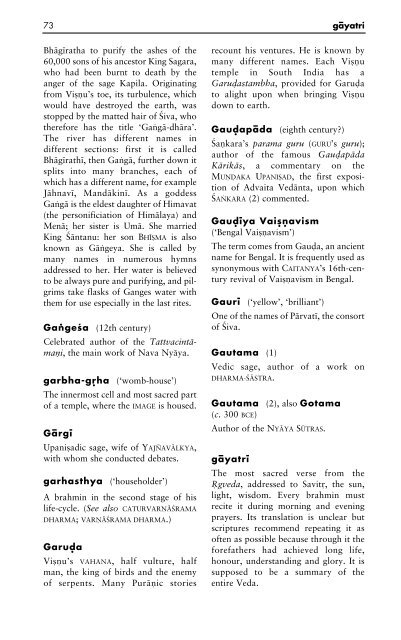A Concise Encyclopedia of Hinduism Klaus K Klostermaie
You also want an ePaper? Increase the reach of your titles
YUMPU automatically turns print PDFs into web optimized ePapers that Google loves.
73 gäyatri<br />
Bhägïratha to purify the ashes <strong>of</strong> the<br />
60,000 sons <strong>of</strong> his ancestor King Sagara,<br />
who had been burnt to death by the<br />
anger <strong>of</strong> the sage Kapila. Originating<br />
from Vi•æu’s toe, its turbulence, which<br />
would have destroyed the earth, was<br />
stopped by the matted hair <strong>of</strong> Ÿiva, who<br />
therefore has the title ‘Gaögä-dhära’.<br />
The river has different names in<br />
different sections: first it is called<br />
Bhägïrathï, then Gaögä, further down it<br />
splits into many branches, each <strong>of</strong><br />
which has a different name, for example<br />
Jähnavï, Mandäkinï. As a goddess<br />
Gaögä is the eldest daughter <strong>of</strong> Himavat<br />
(the personificiation <strong>of</strong> Himälaya) and<br />
Menä; her sister is Umä. She married<br />
King Ÿäntanu: her son BHÏÆMA is also<br />
known as Gäögeya. She is called by<br />
many names in numerous hymns<br />
addressed to her. Her water is believed<br />
to be always pure and purifying, and pilgrims<br />
take flasks <strong>of</strong> Ganges water with<br />
them for use especially in the last rites.<br />
Gaögeÿa (12th century)<br />
Celebrated author <strong>of</strong> the Tattvacintämaæi,<br />
the main work <strong>of</strong> Nava Nyäya.<br />
garbha-gøha<br />
(‘womb-house’)<br />
The innermost cell and most sacred part<br />
<strong>of</strong> a temple, where the IMAGE is housed.<br />
Gärgï<br />
Upani•adic sage, wife <strong>of</strong> YAJÑAVÄLKYA,<br />
with whom she conducted debates.<br />
garhasthya (‘householder’)<br />
A brahmin in the second stage <strong>of</strong> his<br />
life-cycle. (See also CATURVARŒÄŸRAMA<br />
DHARMA; VARŒÄŸRAMA DHARMA.)<br />
Garuõa<br />
Vi•æu’s VAHANA, half vulture, half<br />
man, the king <strong>of</strong> birds and the enemy<br />
<strong>of</strong> serpents. Many Puräæic stories<br />
recount his ventures. He is known by<br />
many different names. Each Vi•æu<br />
temple in South India has a<br />
Garuõastambha, provided for Garuõa<br />
to alight upon when bringing Vi•æu<br />
down to earth.<br />
Gauõapäda (eighth century?)<br />
Ÿaækara’s parama guru (GURU’s guru);<br />
author <strong>of</strong> the famous Gauõapäda<br />
Kärikäs, a commentary on the<br />
MUŒ¥AKA UPANIÆAD, the first exposition<br />
<strong>of</strong> Advaita Vedänta, upon which<br />
ŸA¢KARA (2) commented.<br />
Gauõïya Vai•æavism<br />
(‘Bengal Vai•æavism’)<br />
The term comes from Gauõa, an ancient<br />
name for Bengal. It is frequently used as<br />
synonymous with CAITANYA’s 16th-century<br />
revival <strong>of</strong> Vai•æavism in Bengal.<br />
Gaurï (‘yellow’, ‘brilliant’)<br />
One <strong>of</strong> the names <strong>of</strong> Pärvatï, the consort<br />
<strong>of</strong> Ÿiva.<br />
Gautama (1)<br />
Vedic sage, author <strong>of</strong> a work on<br />
DHARMA-ŸÄSTRA.<br />
Gautama (2), also Gotama<br />
(c. 300 BCE)<br />
Author <strong>of</strong> the NYÄYA SÜTRAS.<br />
gäyatrï<br />
The most sacred verse from the<br />
Øgveda, addressed to Savitø, the sun,<br />
light, wisdom. Every brahmin must<br />
recite it during morning and evening<br />
prayers. Its translation is unclear but<br />
scriptures recommend repeating it as<br />
<strong>of</strong>ten as possible because through it the<br />
forefathers had achieved long life,<br />
honour, understanding and glory. It is<br />
supposed to be a summary <strong>of</strong> the<br />
entire Veda.


















